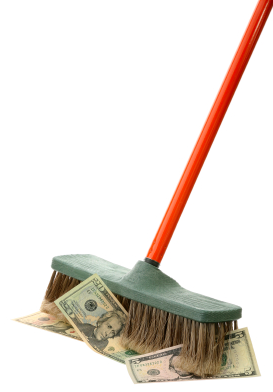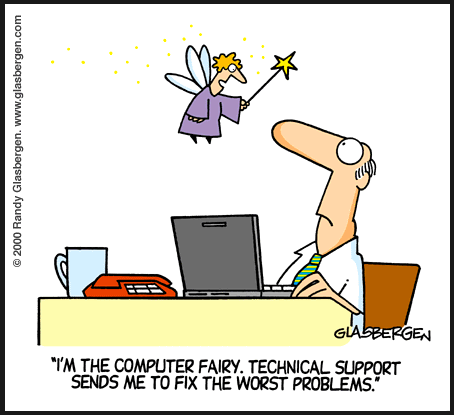It happens to everyone now and then. Nobody bats 100%. Options traders need a repair kit with tools you can use to fix trading problems, or at least bring in extra money to pay for any expected shortfall. The solution is almost always the same: collect more money!
So here's seven things you can do to solve a broken or losing trade. I recommend you practice these on paper until you are confident in your ability to use them. How you and when you use these tools is up to you. After all, you don't use a screwdriver to repair a light socket. Or a sledge hammer to fix a clock.
Each repair strategy is ideal for a particular situation. You will have to determine which strategy works best for your troubled trade. Treat each options position separately, and apply the best strategy to each. Remember your goal is to make a profit or break even on 8/10 of your positions!
1. Wait and do nothing. The stock might turn around.
The stock has a 50% chance of reversing and saving you. Works best when single stock reacts to a rumor, earnings announcement, dividend announcement, or trades close to your strike. Maybe you had your strikes set too close anyway.
Don’t count on this strategy near the beginning of a general market correction, which usually lasts 2-4 months. If your option expires in three weeks, and overall sentiment is bearish, you can count on the stock sinking further around expiration as volume picks up.
And don't count on this if you have less than week to expiration. Even a big ship can turn, but it takes a while! You need time for the price to redirect in your favor.
WHAT TO DO: Don't panic! Don't throw in the towel on a position or give your money easily! Monitor carefully. Focus on where you CAN earn income, often by selling another option position. Learn the available strategies and be ready for a "Plan B" if necessary.
2. Close out any highly profitable positions, and keep the money.
This is standard practice in trade management. If you have an Iron Condor, and one side is in trouble, then that means you are very profitable on the other. Either your Call spread will be ready to close (If stock is heading down) or your Put spread will be very profitable (if stock is heading up). So buy them back for about $0.10 (or up to .10 per month) and prepare to go to 3. below.
 3. Sell another "paired" option and collect more money. Turn your Iron Condor into an Iron Fly.
3. Sell another "paired" option and collect more money. Turn your Iron Condor into an Iron Fly.
If you have sold a Put credit spread, then consider adding a Call spread, and vice versa. Maybe you closed one side of your Iron Condor and should collect more money by selling that same side again. By "paired" I mean with the same expiration, and same number of contracts. This will usually turn your overall position into an Iron Condor, or an Iron Butterfly, but it may also be a short Straddle or short Strangle. It takes no more margin money, and will help you add to your cash. You might even end up making money on both positions, but you can't be wrong twice at expiration. (Just don't overlap your short options, as you will be required to put up extra margin money.) Meanwhile, it is always good to collect more money and sock it away in the account--in case you have to buy your way out of trouble later.
If you already have an Iron Condor, and the stock is at your sold strike, consider rolling up (or down) your sold position so that it shares a common strike with the other end of the Iron Condor. Minimum you collect here should be 40% of available credit (50-60% is even better). This will make an Iron Fly.
HOW TO DO THIS: Sell OTM Calls or Puts, but using the same month of expiration. Go out a further month if you need more premium (may take more margin money). Buy back the entire Iron Condor position when you have significant profit.
4. Buy back your short position and hold the long.
When support collapses, stocks can fall quickly, creating a paper loss in a bullish or bearish position. If you have been trading credit spreads, you will see the premium rising instead of falling. But its not a real loss until expiration or unless you choose to close the trade at a loss. You bought an insurance leg, and now is the time to use it. The long Put leg is there to protect you from loss, so let it do its job..
WHAT TO DO: When the stock crosses your short strike, BUY BACK the short position and HOLD the long, until you are at break even or are profitable. The amount of movement can be calculated using the records you have kept.
EXAMPLE: You collected 3.30 on an $10 strike Iron Condor, 1.60 on the Put side, and 1.70 on the Call side. The price moves quickly down into the zone between your two Put legs. The original price on your sold Put was 5.00 but now its 7.00, and the insurance leg is at 3.00. Buy back the Sold Put at 7.00 and hold the insurance leg until you break even or better. HOW TO CALCULATE: You need to make enough money on the insurance leg to make up for the loss on the sold leg. You lost 2.00, so now add 2.00 to the price of the insurance and place order to sell at at 5.00. Or hold it for greater profit, with a STOP LIMIT order.
(Variation: If unsure, buy back just half your short position. This works better when you have a longer expiration time.)
5. Buy hedging Calls or Puts
If you want to prevent your account going further into negative on a trade, consider hedging with a Put or Call with a deep ITM option delta of .9 or above. This action performs like a firewall, effectively freezing the stock price where it is. (Sorry for mixing metaphors!)
Before the bottom legs (the Puts) of your iron condor or Bull Put Spread are crossed, and the general market keeps going lower, consider buying Put options to collect money as prices go down. You will be putting out money, so be ready to sell the put when you have significant profit. Use your Analyze function to determine profitability point to close out the whole position.
WHAT TO DO: If stock is bearish, buy long Puts. If stock is bullish, buy long Calls. The ideal delta will be .9 to 1.0 (or -1.0 for Puts) but you can always add one contract to simulate the needed effect. For example, 11 contracts at .90 will act the same as 10 contracts at .99.
Sometimes, if volatility is moderate to high, you should sell deep ITM in the money Calls or Puts with the intention of buying them back cheaper later. This trade allows you to both hedge and create profit if managed correctly. Remember that this strategy is the reverse of the normal credit credit spread, and should be used with caution. In addition, the chance of being put or assigned stock increases with this strategy. (Unless you have actual stock you are protecting, you will need to buy an insurance option.).
WHAT TO DO: If stock is bearish, sell deep ITM Call options with delta of .9 or above, plus insurance slightly ITM or near the strike of your original spread. If stock is very bullish, sell deep ITM Put options with delta of .9 or above, plus insurance slightly ITM or near the strike of your original spread.
7. Stair Master
This is an advanced strategy and should be used with caution! It is used to rescue a trade in which the price has moved deep ITM and the stock has a larger ATR (such as CMG or PCLN). The strategy involves holding the short position and selling the long position one or more times before the stock then reverses direction. It works on the principle that every large move is soon reversed. Here are the conditions:
- stock price has. moved beyond both strikes of your iron ciondor
- there are several weeks left in the options
- you keep collecting credits by selling your insurance
- you calculate your break even point and close the trade when you reach it
 HOW IT WORKS: Stock moves down suddenly on news or earnings announcement, crossing both strikes. DO NOT CLOSE THE TRADE! Instead hold both positions and prepare to ride the market all the way down. Wait until momentum slows, and then sell your insurance strike for a large profit, and simultaneously buy insurance at a lower ITM strike, usual the vertical spread tool. In the meanwhile you collect a big insurance check! (Don't attempt this before earnings announcements, as the premiums will be quite high and you might overpay on your protective strike.).
HOW IT WORKS: Stock moves down suddenly on news or earnings announcement, crossing both strikes. DO NOT CLOSE THE TRADE! Instead hold both positions and prepare to ride the market all the way down. Wait until momentum slows, and then sell your insurance strike for a large profit, and simultaneously buy insurance at a lower ITM strike, usual the vertical spread tool. In the meanwhile you collect a big insurance check! (Don't attempt this before earnings announcements, as the premiums will be quite high and you might overpay on your protective strike.).
At this point, the stock will either go up or down to find support. If it drops further, then sell the insurance again and collect more money. Whenever one vertical closes, place an order for the next one. Use delta as your guide, and place the trade when delta is above -.85 (for Puts) or .85 (for Calls). At some point, the stock will turn up again and start riding above your new long Put (Insurance) position. Calculate your break even point and buy back the original short position when profitable (or close half and hold the other for even more profits, closing at even higher stock price).
HOW TO USE: Only use this when you have at least a month or two left on your option. It will usually take several weeks for a stock to turn around. Place your insurance leg for sale in a vertical trade, buying a lower strike, for approximately 90% of available credit. As soon as the trade fills--putting at least $9 (or 90% of the distance between the strikes) into your account--put the new leg up for sale also for 90% profit again, buying an even lower one. At some point, you will stop getting fills on your orders because the stock has turned! Watch for ""topping" and "bottoming" action and close the entire position when at break even or better.
This strategy not only rescues trades which go very deep in the money, but can result in substantial profits =after the stock turns in the other direction.
One final tip .... Split Your Losing Positions
Sometimes it pays to divide your losing position in half and try to break even using two different strategies. Pair a tool that assumes the stock will turn around with one that assumes the stock will go deeper into negative territory. Practice them on paper many times before using in a funded account.
IRON CONDORS: If you already have some profit in the trade, then trade out enough of your losing position to match the income you received. For example if you have an iron condor, collecting $1.50 on each side, then you can afford to lose $1.50 on one side (your loser) and still break even. Use another strategy above to get out of the other half with profit.
VERTICAL SPREADS: If you have 4 contracts, then take two and cash them out at even money with your income. You've reduce your risk in half and broken even. Then use one of the strategies above to become profitable overall.
Remember: Collecting money now is the best insurance against losing money later! In addition, there are ways to turn your Iron Condor and other spreads into a no-risk trade. More on this later!
Now for HOMEWORK....
- Take any position in which you are losing money and prepare a rescue plan using one of the above techniques. You might split some of them, choosing to use 5 contract to do one, and 5 contracts to do another. Then watch and see which works out better.
- Take some positions in which you have at least 30% profit and add deep ITM positions to create a no-lose trade. For example, take an Iron Condor with profit and add deep-ITM Puts if you expect the price to keep going up. Use the Analyze/Risk Profile tool to determine the best placement of strikes. don't feel obliged to use the same expiration for the deep-ITM as for the Iron condor. (It will have its own margin requirement.)
-----------------------------------------------------------------
<script>
(function(i,s,o,g,r,a,m){i['GoogleAnalyticsObject']=r;i[r]=i[r]||function(){
(i[r].q=i[r].q||[]).push(arguments)},i[r].l=1*new Date();a=s.createElement(o),
m=s.getElementsByTagName(o)[0];a.async=1;a.src=g;m.parentNode.insertBefore(a,m)
})(window,document,'script','//www.google-analytics.com/analytics.js','ga');
ga('create', 'UA-47876525-1', 'wordpress.com');
ga('send', 'pageview');
</script>
All right reserved. Copyright 2014-2016 Graeme Sharrock and Honolulu Options Traders, LLC

